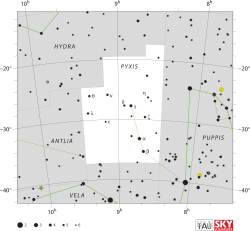Gamma Pyxidis
Gamma Pyxidis (γ Pyxidis, förkortat Gamma Pyx, γ Pyx) som är stjärnans Bayerbeteckning, är en ensam stjärna[10] belägen i den mellersta delen av stjärnbilden Kompassen. Den har en skenbar magnitud på 4,01[2] och är synlig för blotta ögat där ljusföroreningar ej förekommer. Baserat på parallaxmätning inom Hipparcosuppdraget på ca 15,7[1] mas, beräknas den befinna sig på ett avstånd på ca 207 ljusår (ca 64 parsek) från solen.
| Gamma Pyxidis (γ) | |
 | |
| Observationsdata Epok: J2000.0 | |
|---|---|
| Stjärnbild | Kompassen |
| Rektascension | 08t 50m 31,92282s[1] |
| Deklination | -27° 42′ 35,4421″[1] |
| Skenbar magnitud () | +4,010[2] |
| Stjärntyp | |
| Spektraltyp | K3 III[2] |
| U–B | +1,368[3] |
| B–V | +1,284[3] |
| Astrometri | |
| Radialhastighet () | +24,5 ± 0,7[4] km/s |
| Egenrörelse (µ) | RA: -134,31[1] mas/år Dek.: +87,89[1] mas/år |
| Parallax () | 15,73 ± 0,17[1] |
| Avstånd | 207 ± 2 lå (63,6 ± 0,7 pc) |
| Absolut magnitud () | +0,00[5] |
| Detaljer | |
| Massa | 1,64[2] M☉ |
| Radie | 21,87[6] R☉ |
| Luminositet | 178[7] L☉ |
| Temperatur | 4 270[8] K |
| Metallicitet | -0,05[8] dex |
| Ålder | 4,29 ± 2,49[6] miljarder år |
| Andra beteckningar | |
| γ Pyx, CPD-27° 3442, FK5 332, GC 12216, HD 75691, HIP 43409, HR 3518, SAO 176559 [9] | |
Egenskaper redigera
Gamma Pyxidis är en orange till röd jättestjärna av spektralklass K3 III[2]. Den har en massa som är ca 1,6[2] gånger större än solens massa, en radie som är ca 22[6] gånger större än solens och utsänder från dess fotosfär ca 178[7] gånger mera energi än solen vid en effektiv temperatur på ca 4 270[8] K.
Gamma Pyxidis är en röd jättestjärna på den horisontella grenen[11], vilket anger att den genererar energi genom fusion av helium i dess kärna. Sammansättningen av dess stjärnatmosfär liknar solens och den har ungefär samma överskott av järn i sitt spektrum.[12]
Källor redigera
- Den här artikeln är helt eller delvis baserad på material från engelskspråkiga Wikipedia, tidigare version.
Referenser redigera
- ^ [a b c d e f] van Leeuwen, F. (2007). "Validation of the new Hipparcos reduction". Astronomy and Astrophysics. 474 (2): 653–664. arXiv:0708.1752 . Bibcode:2007A&A...474..653V. doi:10.1051/0004-6361:20078357.
- ^ [a b c d e f] Luck, R. Earle (2015), "Abundances in the Local Region. I. G and K Giants", Astronomical Journal, 150 (3), 88, arXiv:1507.01466 , Bibcode:2015AJ....150...88L, doi:10.1088/0004-6256/150/3/88.
- ^ [a b] Gutierrez-Moreno, Adelina; Moreno, Hugo (June 1968), "A photometric investigation of the Scorpio-Centaurus association", Astrophysical Journal Supplement, 15: 459, Bibcode:1968ApJS...15..459G, doi:10.1086/190168
- ^ Gontcharov, G. A. (November 2006), "Pulkovo Compilation of Radial Velocities for 35495 Hipparcos stars in a common system", Astronomy Letters, 32 (11): 759–771, arXiv:1606.08053 , Bibcode:2006AstL...32..759G, doi:10.1134/S1063773706110065.
- ^ Anderson, E.; Francis, Ch. (2012), "XHIP: An extended hipparcos compilation", Astronomy Letters, 38 (5): 331, arXiv:1108.4971 , Bibcode:2012AstL...38..331A, doi:10.1134/S1063773712050015.
- ^ [a b c] Reffert, Sabine; et al. (2015), "Precise radial velocities of giant stars. VII. Occurrence rate of giant extrasolar planets as a function of mass and metallicity", Astronomy & Astrophysics, 574: A116, arXiv:1412.4634 , Bibcode:2015A&A...574A.116R, doi:10.1051/0004-6361/201322360.
- ^ [a b] Mallik, Sushma V. (December 1999), "Lithium abundance and mass", Astronomy and Astrophysics, 352: 495–507, Bibcode:1999A&A...352..495M
- ^ [a b c] Cenarro, A. J.; et al. (2007), "Medium-resolution Isaac Newton Telescope library of empirical spectra - II. The stellar atmospheric parameters", Monthly Notices of the Royal Astronomical Society, 374 (2): 664–690, arXiv:astro-ph/0611618 , Bibcode:2007MNRAS.374..664C, doi:10.1111/j.1365-2966.2006.11196.x
- ^ "gam Pyx", SIMBAD, Centre de Données astronomiques de Strasbourg, hämtad 2009-06-03
- ^ Eggleton, P. P.; Tokovinin, A. A. (September 2008), "A catalogue of multiplicity among bright stellar systems", Monthly Notices of the Royal Astronomical Society, 389 (2): 869–879, arXiv:0806.2878 , Bibcode:2008MNRAS.389..869E, doi:10.1111/j.1365-2966.2008.13596.x.
- ^ Alves, David R. (August 2000), "K-Band Calibration of the Red Clump Luminosity", The Astrophysical Journal, 539 (2): 732–741, arXiv:astro-ph/0003329 , Bibcode:2000ApJ...539..732A, doi:10.1086/309278.
- ^ ^ Keenan, Philip C.; Barnbaum, Cecilia (June 1999), "Revision and Calibration of MK Luminosity Classes for Cool Giants by HIPPARCOS Parallaxes", The Astrophysical Journal, 518 (2): 859–865, Bibcode:1999ApJ...518..859K, doi:10.1086/307311



